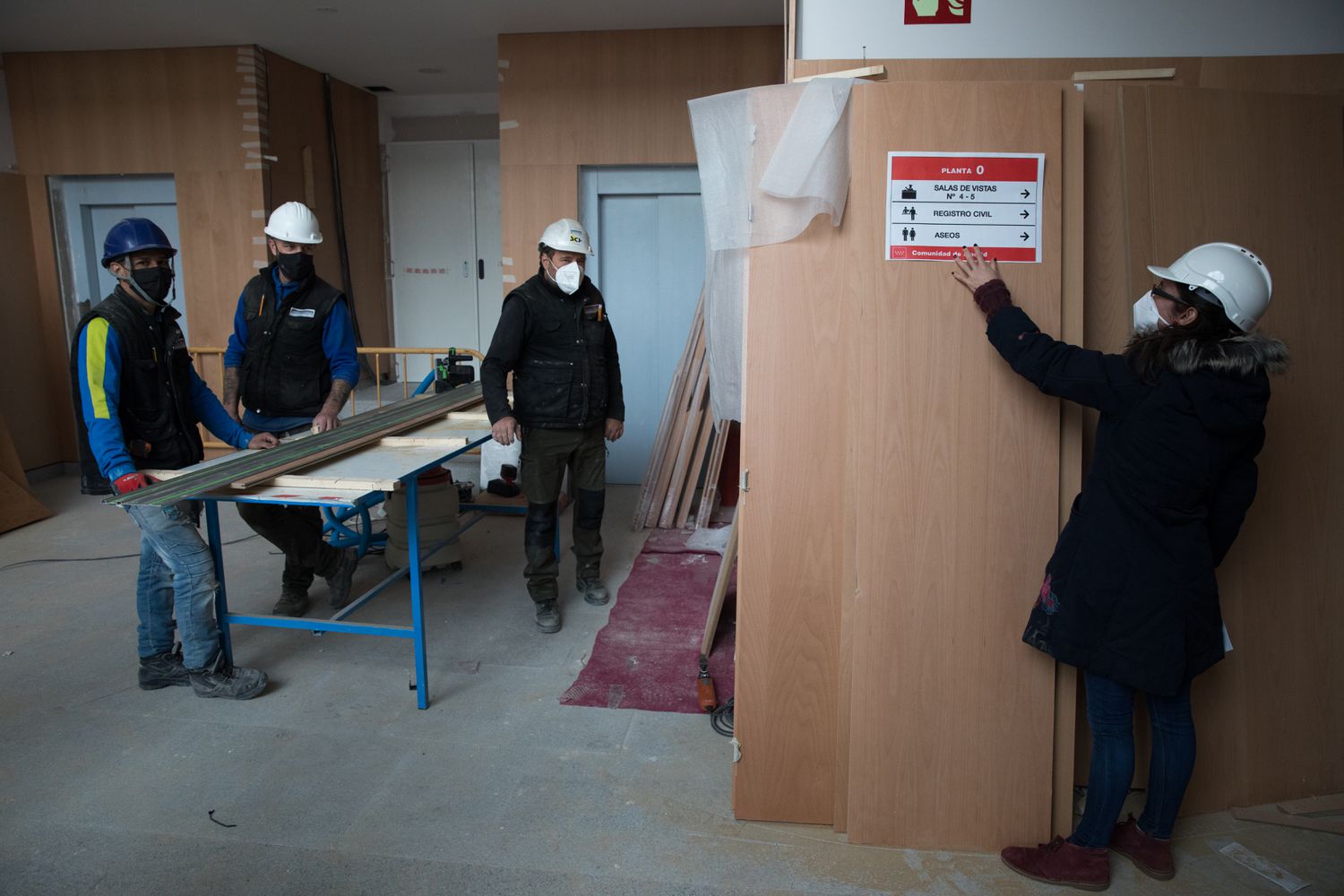
Audit Universal Accessibility In Justice
Where would you put it?
Here, with a banner, so that we can see it better from afar.
María Esteban, 36, has no doubts. She enters determined to a future court in works with a white helmet and a plan of the building under her arm. As you walk through the door, you point to an abstract dot on the wall among dozens of bricklayers wandering the corridors of this four-story justice center.
“Here, here,” he points his index finger at a wall on the first floor. So shall. There, two universal logos will be located in the coming weeks. Two pictograms as basic as the man and the woman that can be seen at the entrance of any bathroom.
“I’m an evaluator,” Esteban says with a smile that escapes from his mask. “I am very cane, I do not allow any failure.” Esteban has come this Thursday to San Lorenzo de El Escorial. Your work is essential for your collective.
People with cognitive disabilities have been forgotten by the institutional bureaucracy for many years. For them, entering a court can be a labyrinth with no way out. The reality when it comes to building any public building is very stubborn. Until very recently no one thought about them.
“We have always worked the other way around,” observes social worker Javier Alonso, 34. Alonso belongs to the Afanias association, which was born in Madrid in 1964 and is already a benchmark in intellectual disability.
“Until now we have been working in spaces where signage was already installed. Our job was to change and improve it, but this is new. Coming to a building under construction and working from the beginning is much better for them ”. A pioneering idea in Spain that arises from a recent agreement between the Ministry of Justice and Plena Inclusión Madrid, the organization that brings together the 116 associations in the region.
“Today the legislation is very stopped in this matter”, says Óscar García, coordinator of Cognitive Accessibility and Easy Reading projects at Plena Inclusión Madrid. Since 1993 there has been a law in the region that establishes the conditions that all public buildings must meet to be accessible.
“The problem”, points out García, “is that the non-specific regulations that they must be the ones to analyze from the outset. With this project we make people with cognitive disabilities come before the official inauguration and they are the ones who detect the barriers that go unnoticed for us ”. Most public buildings have signs in place. “Many times we go to places with them and they tell us in amazement: ‘Why is that sign there? This doesn’t make sense here!’
Understand and orient yourself. There is everything. Jorge Ignacio Aldevilleta, 44, is the second evaluator and one of 40,000 people with cognitive disabilities in the community. “We do this by placing the posters by eye, because for us it is something innate.
There are museums, for example, that for people like us are not well oriented ”. Being a professional evaluator is equivalent to one year of training in different courses. Aldevilleta, in the midst of the noise of drills and corridors full of huge wooden tabloids, now points out where the emergency posters and the private areas on the first floor should go.
“This has to be hung from the ceiling, so that it can be seen from the entrance.” The rest of the coordinators listen to it and write it down carefully. In the next few days they will pass a report to the Ministry of Justice.
The result will be seen in the coming weeks when the posters where they said themselves are implanted. “We defend the need to build ever more humane judicial headquarters, adapted to society as a whole,” underlines the counselor Enrique López.
How many days have these volunteers worked to get here? “The key to everything is that they themselves be trained,” responds the coordinator García. It all depends on the size of the building. For the Prado Museum, for example, we went five times.
They detected numerous barriers. Months later, the museum itself printed a map with the location of the best works for people with disabilities with the idea that the volunteers captured. No one will miss Las Meninas anymore. Both María Esteban and Ignacio Aldevilleta work in the occupational centers. The organizations of people with cognitive disabilities in Madrid want this to soon become a job for them.
The new court in San Lorenzo de El Escorial, which has cost about eight million euros, will open in mid-March. It will serve the 86,000 residents who live in the 12 municipalities in the northern part of the region. “If the building is built well from the beginning”, observes another technician who accompanies the two volunteers with cognitive disabilities, “there are hardly any crossroads.
It is not like hospitals. This is new for everyone and both Ignacio and María are responding much better than I expected. Keep in mind that this is a court and we cannot put up all the posters they want. Reporting more is sometimes less. You have to report just and well and they know it ”. The volunteer Ignacio Aldevilleta responds attentively to the monitor: “Sure. We feel useful and, since you spend public money,


